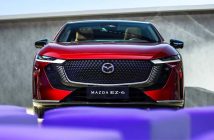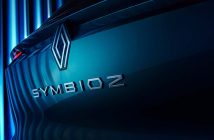+++ Remember the AUDI RS 6 GTO concept? Well, it’s here. Just when you thought Audi’s brutish RS 6 couldn’t get any more badass, VW’s luxury subsidiary comes along and one-ups itself. Meet the Audi RS 6 Avant GT: a model limited to just 660 units. Still interested? Well of course, because it’s a sexy, twin-turbo, V8-powered station wagon that looks like a race car. The GT’s wild appearance is a feature, not a bug. All 660 units will be finished as you see here, in Arkona White with the Audi Sport heritage decal package. Let’s take a closer look. We’d start under the hood, but there’s not much news there; per Audi, the GT will make the same power as the existing RS 6 Performance (630 hp). What you will get is a redesigned body wrapped in copious amounts of carbon fiber: hood, fenders, bumpers, you name it. The roof edge spoiler is unique too, as is the rail-less roof spoiler itself. The GT also wears unique 22-inch wheels finished in Avus (not Arkona) White. The GT will also come equipped with ceramic brakes and a manually adjustable coil-over suspension. Audi says it’ll drop the RS 6 an additional 10 mm compared to the lowest setting offered by the Performance model’s adaptive ride height. A panoramic sunroof is standard, which sure looks neat, but I’m not sure which race car inspired a heavy piece of glass in the tippy-top of the cabin. It’s okay; being lightweight was never the RS 6’s thing. We’ll let it slide. Look for final specs on the RS 6 GT as we get closer to its launch in the second quarter of 2024. +++
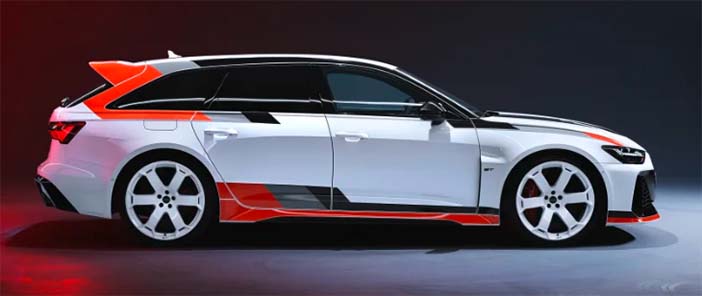
+++ At the J.D. Power Auto Summit in Las Vegas, a DODGE exec told the audience that the production version of the next-generation battery-electric Charger Daytona SRT concept would debut on March 5. That gives us a couple of weeks to wait for the evolution of American muscle. The executive, Matt McAlear, senior vice president of Dodge/SRT sales and marketing, said that primary revisions to the concept concern the side mirrors and the wheels. Otherwise, “this is the real thing”, which appears to be everything visible on insider spy photos. That means a 2-door fastback (yes, fastback: there’s no trunk back there) establishing precedents for all that follows, which has to include a 4-door version. We’re stoked about a proper coupe on the way, however, Dodge sold almost exactly 45.000 Challengers in 2023 and almost exactly 76.000 Chargers. And we know Stellantis CEO Carlos Tavares is 100% money-driven. The production car will sit on Stellantis’ STLA Large platform, which the automaker said earlier this month could propel sedans to a range of 800 km. Don’t expect that from the Charger Daytona SRT, even with the help of the R-wing in front. McAlear said, “We’re not going for the lowest drag coefficient, we’re not going for the highest mileage. We’re going to truly set a new bar”. This shouldn’t worry Challenger fans too much, though, since the most frugal ICE-powered Challenger is only estimated to get 680 km on a full tank. A bar the automaker plans to match, and not reset, centers on the exhaust. The sales exec said the Fratzonic Chambered Exhaust is “just as loud as today’s Hellcat”, able to hit a neighborhood-waking 126 decibels. +++
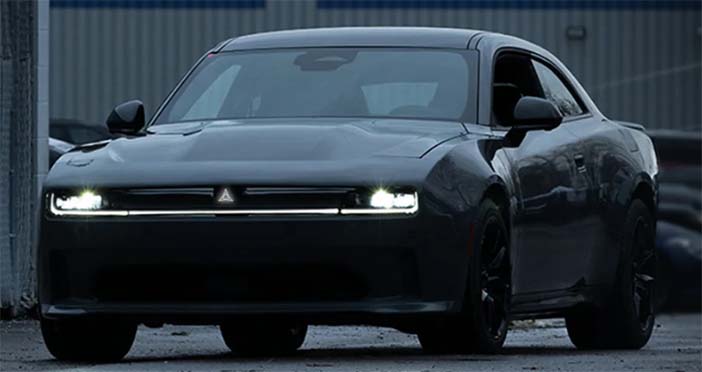
+++ LOTUS is planning another electric sports car. It bears the internal code Type 135 and could reportedly be relatively affordable. The British performance brand plans to unveil the new model in 2025 and set the price at around €90.000 in the Netherlands when it goes on sale in 2027. “We need the bullseye of the brand, and that has to be this two-seater sports car. Otherwise we are just a brand with a Lotus badge. The sports car is an essential part of our future”. The Type 135 will replace the Elise and Emira in the Lotus range. It will be a 2-seater and will be based on the LEVA (Lightweight Electric Vehicle Architecture), which was originally developed for the now-discontinued model collaboration between Lotus and Alpine (see teaser image). The chassis structure is reportedly 37 percent lighter than that of the Emira, although the final weight is likely to be higher due to the heavy battery pack. Single and twin-motor powertrains will be available, reportedly producing 485 hp and 900 hp respectively. The platform can be fitted with either rear-wheel or all-wheel drive, although Lotus won’t rule out the possibility of using a torque-distributing all-wheel drive system similar to the Evija’s system. Whilst these figures are undoubtedly strong, they are slightly lower than Lotus’ other electric vehicles. The Emeya saloon is available with an output of up to 918 hp. The Eletre is available in 2 versions with 612 or 918 hp. According to reports, 66.4 kWh and 99.6 kWh batteries will be available, providing a range of around 480 km and 720 km respectively. Instead of placing the batteries under the floor like many electric cars, Lotus plans to stack them behind the driver. This will allow occupants to sit slightly lower to provide a more traditional sports car experience that buyers have come to expect from the brand. Lotus will build the Type 135 in England. This is in contrast to the Emeya and Eletre, which will be made in China. The company estimates that 10.000 to 15.000 units of the sports car can be sold worldwide each year. +++
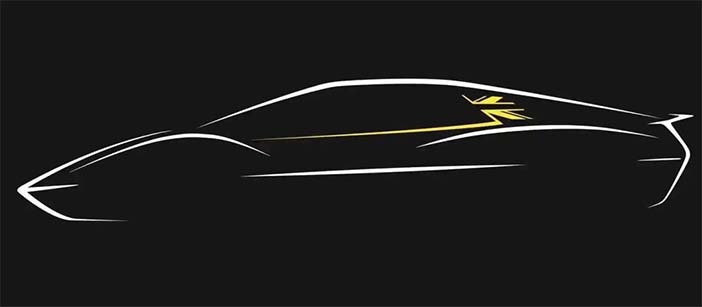
+++ Another day, another MAZDA rotary engine story, except this time, it’s from the automaker itself instead of a third-party speculator. Mazda announced a new division to “accelerate its research and development of rotary engines”. Mazda restarted its RE Development Group within the Powertrain Technology Development Department of Powertrain Development Division (yes, that’s what it’s called). Before we get too excited, Mazda noted that the RE Development Group would focus on the use of rotary tech as generators, also known as EV range extenders. The automaker didn’t explicitly say the engines would be used as primary components in new vehicles, however, so the jury’s still out as to whether we’ll see anything legitimately exciting from the effort. That said, Mazda Chief Technology Officer Ichiro Hirose’s words did seem to hint at exciting rotary-powered cars. “This time, 36 engineers will gather in one group to make a breakthrough in the research and development of RE. In the age of electrification and in a carbon-neutral society, we promise to keep delivering attractive cars that excite customers with our ‘challenger spirit’ ”. Mazda’s electrification efforts have come in fits and spurts. The automaker’s electric MX-30 only offers 200 km of range. It got a rotary range extender though, previewing the revival of Mazda’s RE division. The rotary engine hasn’t been a primary propulsion system for Mazda since the end of the RX-8 in 2012. That car didn’t give the rotary the best sendoff, either, as it suffered from several issues. So, while rotary range extenders might be boring, maybe we should just be happy that Mazda is still working on refining the tech. If we’re lucky, perhaps we’ll get some sort of rotary hybrid sports car in the future. +++
+++ Would you like to drive a car with a plug-in hybrid drive that can also cover well over 100 kilometers in electric mode? Such cars do exist. But which PHEV cars drive the furthest on electric power in Europe? To answer this question, we have compiled a top 5 list, whereby we have also reserved space for the Chinese models, as they offer even greater ranges. The top-5 PHEV cars with the longest electric range are: the GWM Wey 05, the GWM Wey 03, the Mercedes-Benz GL, the Range Rover Sport P460e and the Range Rover P460e. The king of electric range among the plug-in hybrid cars sold in Europe today, the GWM Wey 05 can cover 146 km) in all-electric mode according to the WLTP cycle. This is mainly thanks to the gigantic 39.67 kWh battery. The GWM Wey 05, known as Wey Coffee 01 until last year, is a 4.87-metre-long mid-size SUV with a 2.0-litre petrol engine and 2 electric motors for a total of 476 hp, all-wheel drive and a 9-speed dual-clutch transmission. Slightly more compact, but still with a long electric range, is the GWM Wey 03, another plug-in hybrid SUV that offers a local emission-free range of 136 km thanks to its 34 kWh battery. The 4.66-metre-long GWM Wey 03 is an SUV with all-wheel drive and a 2.0-litre turbo petrol engine coupled with 2 electric motors and a total output of 442 PS. It is also shifted with a 9-speed DCT automatic transmission. Charging can take place via alternating or direct current, with the latter option being offered as standard or as an option for all vehicles in this Top 5. The Mercedes-Benz GLC, in both SUV and SUV-Coupé versions, is currently the king of plug-in hybrids among European brands when it comes to electric range. Depending on the equipment, the locally emission-free range extends from a minimum of 127 km to a maximum of 130 km. The 130 km WLTP-tested electric range is a record shared by the Mercedes-Benz GLC 300e Matic plug-in hybrid and the Mercedes-Benz GLC 400e 4Matic plug-in hybrid. Both are powered by a 2.0-litre turbocharged petrol engine combined with a 136 hp, with the 300e having a combined output of 313 hp and the 400e 381 hp. The GLC 300de 4Matic with a 333 hp diesel engine has a range of 120 km instead. In all versions, the battery has a gross capacity of 31.2 kWh (23.4 kWh net). The Range Rover Sport, in particular the P460e powertrain, takes fourth place in this ranking of plug-in electric marathon runners with a range of 123 km homologated in the combined WLTP cycle. The British SUV with the 3.0-litre R6 petrol engine contributing to the system output of 460 hp has a huge battery with 38.2 kWh gross (31.8 kWh net), the largest capacity of all plug-in hybrids produced in Europe today. The Range Rover Sport P550e, on the other hand, has a maximum EV range of “only” 121 km. The majestic Range Rover, Land Rover’s largest and most luxurious off-roader, also has a plug-in hybrid version with a generous electric range in its program. This is the P460e, which achieves a range of 122 km in the WLTP test. The drive is the same as in the corresponding Sport model and the battery also remains the same at 38.2 kWh (31.8 kWh usable). The even more powerful P550e with 550 hp achieves a maximum range of 120 km. +++
+++ STELLANTIS chairman John Elkann on Monday denied the carmaker was hatching merger plans, responding to press speculation about a possible French-led tie-up with rival Renault. Elkann said that the Peugeot owner, the world’s third largest carmaker by sales, was focused on the execution of its long-term business plan. “There is no plan under consideration regarding merger operations with other manufacturers”, said Elkann, who also heads Exor, the Agnelli family holding company that is the largest single shareholder in Stellantis. After abandoning the Russian market, at the time its second largest after France, and reducing the scope of its global cooperation with Nissan, Renault has been seen as a potential M&A target. Speculation intensified after an electric vehicle market slowdown forced it last week to cancel IPO plans for its EV and software unit Ampere. Its market cap remains stubbornly low at little over 10 billion euros, despite a financial recovery over the past few years. Stellantis, the product of a 2021 merger between France’s PSA and Fiat Chrysler and one of the most profitable groups in the industry, has a market cap of more than 85 billion euros when unlisted shares are factored in. It has a 14 brand portfolio also including Citroën, Jeep, Opel and Alfa Romeo. Italian daily Il Messaggero had said on Sunday that the French government, which is Renault’s largest shareholder and also has a stake in Stellantis, was studying plans for a merger between the 2 groups. A spokeswoman for Renault said on Monday the group did not comment on rumors. France’s Finance Ministry had declined to comment on Sunday. Stellantis has crossed swords with the Italian government, which has accused it of acting against the national interest on occasions. Industry Minister Adolfo Urso last week raised the prospect of the Italian government taking a stake in Stellantis to help to balance the French influence. Renault shares pared gains after Elkann’s comments. Stellantis CEO Carlos Tavares, a Portuguese-national, last week said in an interview that the group was “ready for any kind of consolidation” and that its job was to make sure that it would be “one of the winners”. Analysts, however, question the rationale of a Stellantis-Renault merger, which would also expand the group’s excess capacity in Europe. Renault is led by Luca de Meo, an Italian whose previous roles included working at Fiat. Jefferies last week said that Europe would not be the priority for any potential Stellantis M&A activity, with Renault not offering significant scale in other areas of the world, while a deal would also face antitrust obstacles. +++
+++ Artificial intelligence is no longer just a topic in science fiction films, but is becoming increasingly topical. Numerous companies want to develop software that perfectly understands natural language, learns and continues to develop independently. Not an apocalyptic scenario, mind you … AI is a topic that is becoming increasingly interesting for car manufacturers. Both for infotainment systems and for autonomous driving technologies. Topics that are now to take centre stage at AI Lab; a new company founded by the VOLKSWAGEN GROUP that will focus precisely on artificial intelligence and its applications in the vehicles of tomorrow. According to the press release, the new company will not develop new projects internally, but will act as an “incubator” for new technologies developed by external partners. These technologies will then be further developed by producing the first prototypes. The AI Lab team is made up of experts in the field and will work with all of the Group’s brands to ensure that the new technologies can be implemented in the various models. Advanced voice recognition, optimized charging cycles, predictive maintenance and V2V (Vehicle to Vehicle) and V2X (Vehicle to X) communication will be the focus of the AI Lab’s work. Some of these technologies are already available today, but their potential has not yet been fully utilized. “Our aim is to connect external digital ecosystems with the vehicle and thus create an even better product experience. Collaboration with tech companies is of the utmost importance to us. Infuture, we will make collaboration even easier in terms of organisation and culture”. Carsten Helbing as CEO and Carmen Schmidt as CLO & CBO will take over the management of the AI Lab. High-profile experts from the field of artificial intelligence will be responsible for technical management functions. The Supervisory Board will be made up of members of the Board of Management of the Volkswagen, Audi and Porsche brands. The announcement of the birth of the IA Lab comes just days after the integration of ChatGPT into Volkswagen and Skoda models, using the most popular chatbot on the internet to enhance voice commands, offering the possibility of natural conversations beyond the classic assistants we are used to. +++
+++ Here’s a news item that slipped through the dragnet. I last wrote about the VOLKSWAGEN ARTEON in September 2022, when the OEM said the sophisticated sedan would be killed in 2024. But VW decided to pull the plug early, at the end of production for the 2023 model year. The sedan version of the Arteon has been given the boot first, with Volkswagen’s German site showing only the Arteon Shooting Brake. The sole VW sedan for sale in Europe is the new battery-electric ID.7, known formerly as the ID.Aero and the planned replacement for the Arteon and bygone Passat. The ID.7 is slightly larger. It also offers more passenger and cargo volume then the properly sedan-shaped Passat. The ID.7 in rear-wheel-drive form details an 82-kilowatt-hour lithium-ion pack, a new (oil-and water-cooled) electric motor called AP550 rated at 286 hp and 550 Nm of torque, and a WLTP range of 621 km. +++

